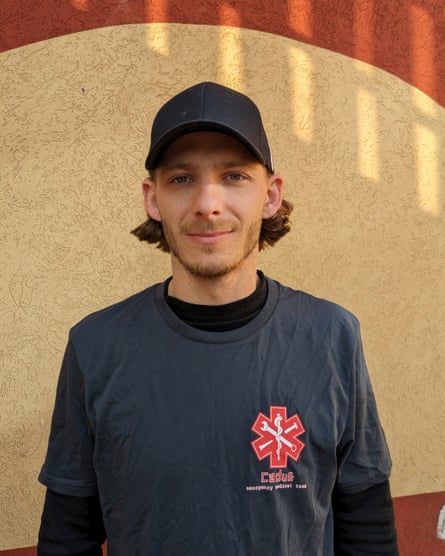
Severely injured patients trapped in Gaza’s hospitals as evacuations are halted
Destruction of buildings, too few ambulances and having to work in ‘red zones’ all adding to trauma
There have been no medical evacuations from northern Gaza for more than a month so severely injured people are trapped in damaged hospitals where they cannot get adequate treatment, a leading medical charity has warned.
Ambulances need urgent access to take the most vulnerable patients for specialist care, said Patrick Münz, head of mission in Gaza for German medical charity Cadus.
There are no intensive care units operating in northern Gaza, so Palestinians most seriously injured in Israeli airstrikes and fighting on the ground have died.
But dozens of patients in the two functioning hospitals in Gaza City have been stabilised after amputations or with severe burns, and could survive if they got treatment in Rafah or beyond Gaza.
Cadus is working with the World Health Organization trying to get ambulances into the north for evacuations, travelling with UN aid convoys bringing food or medical supplies.
“The people we will transport at least at the beginning are critical care patients, but who are stable,” said Münz, adding that there had been no transports for over a month. “They should have been evacuated yesterday already.”

The Palestinian Red Crescent Society (PRCS) halted evacuations after staff on medical convoys came under repeated attack, were harassed and detained by Israeli forces.
The dangers to paramedics were highlighted in late January when two were killed trying to reach six-year-old Hind Rajab, trapped in her family car in Gaza City and surrounded by the bodies of dead relatives after it came under fire.
The PRCS accused Israel of deliberately targeting the ambulance, after the military approved the rescue mission. Israel said its troops were not in the area at the time.
Even for international aid workers, travelling into Gaza City is dangerous and logistically challenging. Unrwa halted food convoys in February after one came under fire from Israeli ships, but the need to get patients out is urgent.
“Of course we also get afraid, I think that is healthy … to understand the risk we are putting ourselves in,” Münz said. “But I’m ready to go, it’s really important that we can start this now.”
Cadus has not been allowed to bring its own ambulances into Gaza, although the UN and the German foreign office are lobbying the Israeli government. For now it is using PRCS vehicles – “this is also pushing the risk because PRCS ambulances have already been targeted”, Münz says – and trying to buy VW Crafters to convert.
The roads have been damaged by months of fighting, so the team need to be prepared for breakdown including with extra spare tyres, and much of the route is through a “red zone” where there is still active combat.
There are likely to be injured people along the roads, and they will not always have the time or resources to stop when their mission is to collect patients from a hospital.
“There is quite a real possibility of there being mass casualties on the way … seriously injured people lying on the streets, because they’ve got hit by a sniper or whatever,” he said. “So it will be also mentally difficult for the team.”
He hopes the first evacuations will happen this week. The WHO submits the names of patients referred to transfer to the Israeli army, which is expected to take two to four days to approve them, then the Israeli army gives a time and route for the evacuation.
after newsletter promotion
On Monday, a Cadus team on a trial mission reached al-Shifa hospital, one of two still functioning in a limited way, serving an estimated 300,000 people trapped in northern Gaza.
Aid workers have described a “siege within a siege” in northern Gaza, with widespread hunger and “pockets of famine”. More than 100 people died when Israeli troops fired near desperate crowds around an aid convoy in late February.
Cadus, which has also operated in emergencies in Ukraine, Iraq, Syria, Bosnia and the Mediterranean, began its mission in Gaza in early February, opening a trauma stabilisation point in Khan Younis district.
Patients from there are sent on to Rafah where there are better equipped field hospitals and some can be transferred to Egypt.
The logistics of operating in Gaza, even in the south, are extremely challenging. Each team of eight people must bring in all their own food, water and medical supplies, and staff who volunteer to serve there are warned that they cannot immediately change their minds. Once inside Gaza, it takes a minimum eight days to get permission from Israeli authorities to cross back over the border.
The team sees about 25 to 45 patients a day, on average. About a third of those treated so far are children, including one girl whose leg was broken by an aid package air-dropped into the area, Münz said.
Münz described a situation he had never experienced in other conflict zones, where patients injured in the “red zone” had to find their own way to hospital, in relatives’ cars or on donkey carts, or even on foot, because it is too dangerous to send ambulances to collect them. Many die on the way.
“People need to come by themselves to our trauma stabilisation points,” he said. “This means that there’s so many patients that are being heavily injured and not even making it to our (medics).
“Of course we have seen civilians getting killed or targeted in Ukraine as well,” he said. “But what we see here, what comes into our trauma stabilisation point, the dead on arrival, sometimes when they’re just bringing a whole family, the mother, father and children. Sometimes it’s really hard to understand why this has to happen in this kind of way.”
Source: theguardian.com



